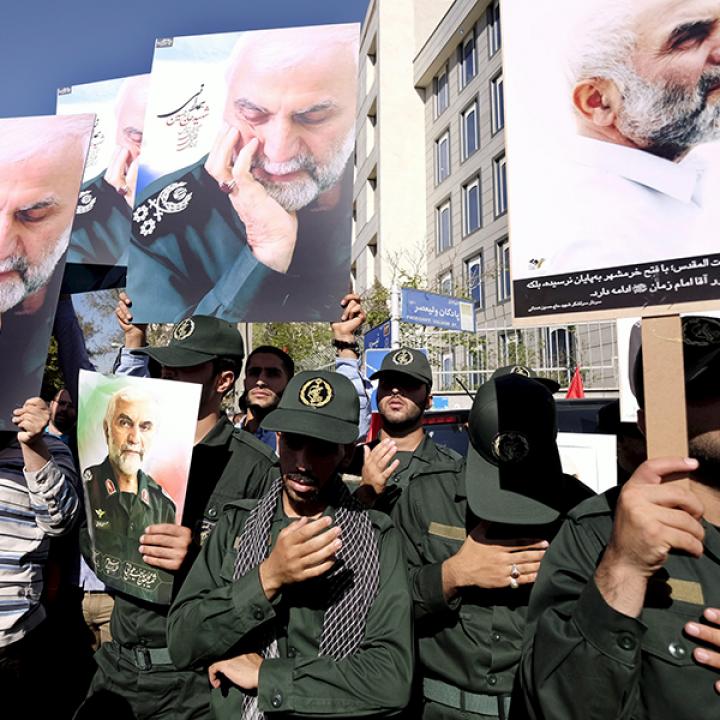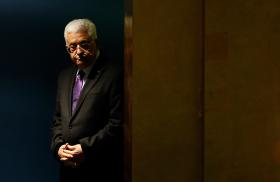
- Policy Analysis
- PolicyWatch 2813
Contain Iran? Fine, But Answer These Questions First

Whatever understandings the Trump administration reaches after the Islamic State is defeated, it needs to be clear about the stakes: if America does not stop the Iranians in Syria and Iraq, they will soon emerge as the region's dominant force.
During his recent meetings with Arab leaders in Riyadh, President Trump signed up to a program of pushing Iran back throughout the region. U.S.-Arab communiques about combating Iranian threats are not new; President Obama endorsed two of them with the Gulf Cooperation Council (GCC) after reaching the nuclear deal with Iran, though he did not seem to believe in that mission or advance it very far. But times have changed. The Trump administration has taken a much more aggressive posture toward Iran, and the region's other main threat, the Islamic State, is waning, at least as a quasi-conventional military force. While candidate Trump focused mainly on IS and the nuclear deal, President Trump appears to be on board with many of his senior military advisors in taking a tougher stance against Tehran's destabilizing regional activities -- a mindset based on their own bitter experiences dealing with Iranian-sponsored violence in Iraq and elsewhere.
For its part, Tehran has become even more aggressive since the nuclear deal, buttressed by Russia's intervention in Syria and an emboldened client regime in Damascus that has shown little interest in negotiating an end to the war. Iran's most recent provocations have prompted U.S. military responses against its surrogates in Syria and Yemen. And while "moderate" president Hassan Rouhani just won a second term, there is little he can do to change Iran's hardline posture abroad even if he wanted to, judging by his lack of effort on that front during his first term and the nature of the Islamic Republic's power structure.
On the rhetorical level at least, the communiques issued after the three Riyadh summits (bilateral, U.S.-GCC, and "Arab Islamic American") are unambiguous. Iran was singled out for its "malign interference," its activities were (sometimes inaccurately) branded as "terrorist," and the signatories committed to act collectively against it. Trump heard a similar message during separate meetings with Israeli and Turkish leaders. But a serious American policy to contain Iran, analogous to the counter-IS campaign or the nuclear negotiations, has not yet been worked out. Such a policy will require more than occasional missile strikes, diplomatic declarations, a Saudi-led "Islamic Military Alliance," and conventional weapons sales (which are helpful in certain ways, but not so much in countering the Iranian threat, which is primarily asymmetrical, ideological, and terrorist rather than conventional).
Tehran has a comprehensive plan of its own and is carrying it out. To formulate their own plan, Washington and its allies will need to answer several strategic questions.
Who is the enemy?
One of Saudi Arabia's main goals in holding the Riyadh summits was to convince participants that Iran posed the greatest threat to the region -- not only as a state, but as a "malign" Shia movement in a largely Sunni Middle East. This was unsurprising, since the Saudis have long portrayed their competition with Iran in religious terms. Yet the more this formulation is adopted, the more absolute the contest becomes, with less potential "give" from Iran (which cannot simply surrender its religious essence) and growing reluctance among allies.
Israel, Turkey, and Egypt all see Iran as a threat, but not in the same terms as Riyadh. For example, Ankara recently referred to "Persian expansionism" as the main concern and avoided Riyadh's sectarian formulations, suggesting that Turkey would prefer traditional Cold War-style containment. The Europeans are even less enchanted with casting the conflict in religious terms; in fact, some of them see "medieval" Saudi Arabia as a bigger problem than Rouhani's "modernist" Iran. The Trump administration will either need to find some common policy ground between these widely variant threat perceptions or be willing to rely more heavily on some partners than others.
Where does the JCPOA fit?
Since taking office, the president has been largely silent about the Joint Comprehensive Plan of Action, the document that laid out the terms of the nuclear deal. Although his administration has adhered to its commitments under the agreement, he has not recanted his campaign promise to tear up the JCPOA.
If he does in fact cancel it, the United States would be blamed for reneging on what most of the world views as a reasonable deal. The idea that Washington could negotiate a tougher agreement with Russia, China, and Europe is simply unrealistic. The result: Iran would be free to move toward nuclear weapons, and the only restraint would be the threat of direct U.S. military action. And if such action became necessary, it might dwarf that seen during the U.S.-led invasion of Iraq.
Alternatively, Trump could formally acknowledge the JCPOA, which would win him friends in some quarters but might encourage Iran to disregard his non-nuclear admonishments. This approach would also worry Saudi Arabia and Israel.
A third option is to leave the agreement in limbo. This would frustrate Europe and Iran but probably please Middle Eastern allies, though they would still expect a serious U.S. containment policy.
How to deal with Iran in Syria and Iraq?
Although Iran is challenging regional security from Yemen to Afghanistan, the key front is Syria and Iraq, where Tehran has long influenced Bashar al-Assad's regime and the Shia-centric government in Baghdad, respectively. Following the 2011 "Arab Spring," Iranian leaders pushed these surrogates to exert greater control, but such efforts also exacerbated the catastrophic developments unfolding in each country: namely, the mass uprising against Assad and the emergence of IS.
Iran has since undertaken an all-out campaign to keep Assad in power and expand its influence in Iraq -- aided, ironically, by the U.S.-led war against IS. As IS forces are ground down in their last redoubts, Mosul and Raqqa, Tehran's surrogates are scurrying to establish a land corridor between Iran, Iraq, Syria, and Hezbollah in Lebanon. The geostrategic shift this portends is extraordinary. As the Bipartisan Policy Center recently pointed out, this could leave 20 million Sunni Arabs in Syria and Iraq under de facto Shia rule, likely incubating a new Sunni extremist movement to replace IS.
This front is critical for other reasons as well. The United States and its allies have established footholds in northern Syria, along the Jordanian border, and in Iraqi Kurdistan, primarily to fight IS. Once the group is defeated, these positions will either have to be abandoned or held against an inevitable storm of Iranian-supported attacks intended to push U.S. forces out. Sticking around indefinitely would require complicated political arrangements with Turkey, Jordan, Baghdad, and various Kurdish and Sunni Arab factions -- and perhaps with Iran and Russia as well. Whatever arrangements are reached, the Trump administration needs to be clear about the stakes: if America does not stop the Iranians on this front, they will soon emerge as the dominant force in the region, deeply inimical to the United States and its allies.
How to respond when Iran strikes back?
If history is a guide, any U.S. effort to confront Tehran will generate attacks on U.S. interests. Since 1979, the regime has struck at U.S. targets directly or through surrogates on multiple occasions, from Kuwait, Lebanon, and Yemen to a thwarted plot in Georgetown. Two examples are particularly relevant: the 1996 Khobar Towers bombing in Saudi Arabia, which killed nineteen American servicemen, and the summer 2011 spurt of targeted killings that took the lives of another sixteen soldiers in Iraq. In response, Washington has either eschewed obvious retaliation or taken action against surrogates outside Iran with mixed results. Whether more direct retaliation inside Iran is on the table or not, U.S. officials need to determine in advance how they will react before they pick a fight.
Should Washington communicate with Tehran?
Secretary of State Rex Tillerson gave an interesting answer to this question while in Riyadh, refusing to rule it out. Limited technical communications with Iran will certainly continue (e.g., between forces in the Persian Gulf; on JCPOA matters). But will Washington press for -- or accept -- a political dialogue? If so, with whom: Foreign Minister Mohammad Javad Zarif or the shadowy Qods Force commander Qasem Soleimani, who is largely responsible for carrying out Iran's regional policies? Would such contacts be open or secret (as they were with the Obama administration at first)? If brokered by a third party, whom? Will Iran even be willing to engage in such dialogue, and at what price? Finally, what end would these talks serve? This leads to the final question below.
What is the ultimate goal with Iran?
To succeed with any policy toward Iran, the United States must set clear final goals. Does it merely want to push back on Tehran's regional aggression, as it did with Slobodan Milosevic in the 1990s? Or does it seek a long-term containment policy to effect fundamental policy changes in Iran (i.e., George Kennan's initial prescription for the Cold War), or even regime change? If so, how would this policy be carried out in practice? Iran experts in the United States are divided on whether toppling the regime or continuing Obama's policy of outreach is the best way to transform Iran; Washington's potential international allies are split on this issue as well. Clarity is therefore crucial if the administration wants to maximize its chances of winning adherents at home and abroad.
James F. Jeffrey is the Philip Solondz Distinguished Fellow at The Washington Institute, former U.S. ambassador to Turkey, Iraq, and Albania, and coauthor of the Transition 2017 paper "General Principles to Guide U.S. Middle East Policy" (with Dennis Ross).



